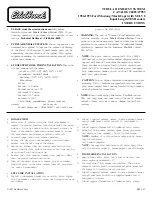
DISCLOSURES
Devices That Emit Radio Waves
The following products and systems, if on your vehicle, emit radio waves when
in operation:
• HondaLink
®
*1
• Audio System
•
Bluetooth
®
Audio
•
Bluetooth
®
HandsFreeLink
®
• Collision Mitigation Braking
System
™
(CMBS
™
)
• Immobilizer System
• Remote Transmitter
*1
• Smart Entry System
*1
Each of the above complies with the appropriate requirements or the required
standards of the FCC (Federal Communications Commission) and Industry
Canada, described below:
As required by the FCC:
This device complies with Part 15 of the FCC rules. Operation is subject to the
following two conditions: (1) This device may not cause harmful interference,
and (2) this device must accept any interference received, including
interference that may cause undesired operation.
Changes or modifications not expressly approved by the party responsible for
compliance could void the user’s authority to operate the equipment.
As required by Industry Canada:
This device complies with Industry Canada licence-exempt RSS standard(s).
Operation is subject to the following two conditions: (1) this device may not
cause interference, and (2) this device must accept any interference, including
interference that may cause undesired operation of the device.
Disclaimer
The information and data contained herein are believed to be accurate and
reliable. American Honda Motor Co., Inc. makes no warranty of any kind and
accepts no responsibility for the results obtained through application of this
information.
Privacy Notice
This vehicle may share location and usage information. To manage this setting,
visit
www.hondalink.com/vehicle-data-choices.
*1 - If equipped
Event Data Recorders
This vehicle is equipped with an event data recorder (EDR). The main purpose
of an EDR is to record, in certain crash or near crash-like situations, such as an
airbag deployment or hitting a road obstacle, data that will assist in
understanding how a vehicle’s systems performed. The EDR is designed to
record data related to vehicle dynamics and safety systems for a short period of
time, typically 30 seconds or less. The EDR in this vehicle is designed to record
such data as:
• How various systems in your vehicle were operating;
• Whether or not the driver and passenger safety belts were buckled/fastened;
• How far (if at all) the driver was depressing the accelerator and/or brake
pedal; and,
• How fast the vehicle was traveling.
These data can help provide a better understanding of the circumstances in
which crashes and injuries occur. NOTE: EDR data are recorded by your vehicle
only if a non-trivial crash situation occurs; no data are recorded by the EDR
under normal driving conditions and no personal data (e.g., name, gender, age,
and crash location) are recorded. However, other parties, such as law
enforcement, could combine the EDR data with the type of personally
identifying data routinely acquired during a crash investigation.
To read data recorded by an EDR, special equipment is required, and access to
the vehicle or the EDR is needed. In addition to the vehicle manufacturer, other
parties such as law enforcement that have the special equipment can read the
information if they have access to the vehicle or the EDR.
The data belong to the vehicle owner and may not be accessed by anyone else
except as legally required or with the permission of the vehicle owner.
Service Diagnostic Recorders
This vehicle is equipped with service-related devices that record information
about powertrain performance. The data can be used to verify emissions law
requirements and/or help technicians diagnose and solve service problems. It
may also be combined with data from other sources for research purposes, but
it remains confidential. Some diagnostic and maintenance information is
uploaded to Honda upon vehicle start up.



































